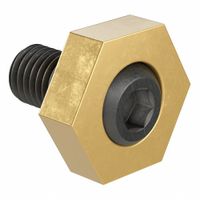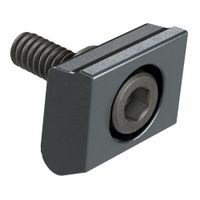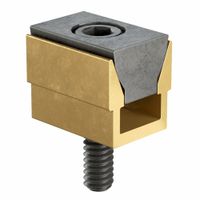Call +(254) 703 030 000 / 751 483 999 / 721 704 777
- Home
- Machining
- Clamping Workholding Positioning
- Fixture Clamps
.....Read More
Frequently Asked Questions
What are fixture clamps used for?
Fixture clamps are essential tools used in manufacturing and machining processes to securely hold workpieces in place during operations such as milling, drilling, welding, and assembly. They ensure precision, stability, and safety by preventing movement or vibration of the workpiece, which could lead to inaccuracies or defects in the final product.
These clamps are integral to the setup of jigs and fixtures, which are custom-designed tools that guide and support the workpiece. By maintaining a firm grip, fixture clamps allow for consistent and repeatable machining processes, enhancing productivity and reducing the likelihood of errors. This is particularly important in high-volume production environments where consistency and efficiency are critical.
Fixture clamps come in various designs, including toggle clamps, cam clamps, strap clamps, and pneumatic clamps, each suited for different applications and workpiece geometries. Toggle clamps, for instance, are known for their quick action and strong holding force, making them ideal for repetitive tasks. Cam clamps offer adjustable pressure and are often used for delicate or irregularly shaped workpieces. Pneumatic clamps, powered by air pressure, provide automated clamping solutions, increasing speed and reducing manual labor.
In addition to machining, fixture clamps are used in welding to hold components in precise alignment, ensuring accurate joints and reducing the risk of warping due to heat. In assembly processes, they facilitate the accurate positioning of parts, contributing to the overall quality and functionality of the assembled product.
Overall, fixture clamps are vital for achieving high-quality, precise, and efficient manufacturing outcomes, making them indispensable in various industrial applications.
How do low-profile fixture clamps work?
Low-profile fixture clamps are designed to hold workpieces securely in place while minimizing obstruction and maximizing accessibility during machining or assembly processes. These clamps are particularly useful in CNC machining, welding, and other precision operations where space is limited and unobstructed access to the workpiece is crucial.
The primary mechanism of low-profile fixture clamps involves a compact design that allows them to exert significant clamping force without occupying much vertical space. They typically consist of a base, a clamping arm, and an actuating mechanism. The base is mounted onto a fixture plate or directly onto the machine table. The clamping arm, which is often adjustable, pivots or slides to apply pressure onto the workpiece.
The actuating mechanism can vary, but common types include:
1. **Screw Mechanism**: A threaded screw is turned to move the clamping arm into position. This type allows for precise control over the clamping force and is often used in applications requiring high precision.
2. **Cam Mechanism**: A cam lever is rotated to engage the clamping arm. This provides quick and easy clamping and unclamping, making it ideal for operations requiring frequent adjustments.
3. **Hydraulic or Pneumatic Actuation**: These systems use fluid or air pressure to move the clamping arm. They offer high clamping force and can be automated for efficiency in high-volume production environments.
Low-profile fixture clamps are designed to exert force horizontally or at a low angle, which helps in maintaining the stability of the workpiece without lifting it off the fixture. This ensures that the workpiece remains in the correct position throughout the machining or assembly process, reducing the risk of errors and improving the quality of the final product.
What is the advantage of using cam action fixture clamps?
Cam action fixture clamps offer several advantages:
1. **Quick Operation**: Cam action clamps allow for rapid clamping and unclamping, significantly reducing setup time and increasing productivity in manufacturing processes.
2. **Consistent Clamping Force**: These clamps provide a consistent and repeatable clamping force, ensuring that workpieces are held securely without the risk of over-tightening or damaging the material.
3. **Ease of Use**: The simple mechanism of cam action clamps makes them easy to operate, requiring minimal training for workers. This simplicity also reduces the likelihood of operator error.
4. **Space Efficiency**: Cam action clamps are typically compact, making them ideal for use in tight spaces or on fixtures where space is limited.
5. **Durability and Reliability**: Made from robust materials, these clamps are designed to withstand repeated use and harsh industrial environments, offering long-term reliability.
6. **Versatility**: They can be used for a wide range of applications and materials, from metalworking to woodworking, making them a versatile choice for various industries.
7. **Reduced Operator Fatigue**: The ergonomic design of cam action clamps minimizes the physical effort required by operators, reducing fatigue and the risk of repetitive strain injuries.
8. **Minimal Maintenance**: With fewer moving parts compared to other clamping systems, cam action clamps require less maintenance, reducing downtime and maintenance costs.
9. **Improved Safety**: The secure and reliable clamping action reduces the risk of workpieces shifting during machining, enhancing safety for operators.
10. **Cost-Effective**: The combination of durability, ease of use, and reduced setup time makes cam action clamps a cost-effective solution for many manufacturing operations.
How do edge and toe clamps differ from other clamps?
Edge and toe clamps differ from other clamps primarily in their design and application.
Edge clamps are specifically designed to apply pressure along the edge of a workpiece. They are often used in woodworking and metalworking to hold pieces securely without obstructing the top surface, allowing for unobstructed access for machining or finishing. Edge clamps typically use a cam or screw mechanism to apply lateral pressure, making them ideal for tasks like gluing or joining panels.
Toe clamps, on the other hand, are used to apply downward force on a workpiece. They are commonly used in machining and metalworking to hold parts securely on a worktable or fixture. Toe clamps have a low profile, which allows them to exert force without interfering with the machining process. They often feature a serrated or textured surface to grip the workpiece firmly, and they can be adjusted to accommodate different thicknesses.
In contrast, other clamps, such as C-clamps or bar clamps, generally apply pressure from above or across the workpiece. These clamps are versatile and can be used for a variety of tasks, but they may obstruct access to the workpiece surface, which can be a limitation in certain applications.
Overall, edge and toe clamps are specialized tools designed to provide secure clamping without interfering with the workpiece surface, making them essential in specific industrial and workshop settings.
What applications are wedge clamps best suited for?
Wedge clamps are best suited for applications requiring secure, precise, and repeatable clamping with high force and minimal effort. They are commonly used in the following areas:
1. **Injection Molding**: Wedge clamps are ideal for securing molds in injection molding machines. Their ability to provide high clamping force ensures that molds remain in place during the injection process, reducing the risk of defects and improving product quality.
2. **Die Casting**: In die casting, wedge clamps are used to hold dies securely. Their robust clamping force and quick-release mechanism facilitate efficient die changes, enhancing productivity and reducing downtime.
3. **Metal Stamping**: Wedge clamps are employed in metal stamping operations to hold dies in place. Their precision and reliability ensure consistent stamping results, which is crucial for maintaining the quality of stamped parts.
4. **Automotive Manufacturing**: In the automotive industry, wedge clamps are used in various assembly and manufacturing processes. They provide the necessary clamping force to hold components securely during machining, welding, and assembly operations.
5. **Aerospace Industry**: The aerospace sector utilizes wedge clamps for their precision and reliability in holding components during manufacturing and assembly processes. Their ability to maintain consistent clamping force is critical for the high standards required in aerospace applications.
6. **Tool and Die Making**: Wedge clamps are used in tool and die making for securing workpieces during machining. Their precision and repeatability are essential for producing high-quality tools and dies.
7. **Robotics and Automation**: In automated systems, wedge clamps are used to hold parts in place during robotic operations. Their quick clamping and release capabilities are beneficial for maintaining the speed and efficiency of automated processes.
Overall, wedge clamps are favored in industries where high clamping force, precision, and efficiency are paramount.
How do inside-diameter fixture clamps function?
Inside-diameter fixture clamps function by securing a workpiece from the inside, allowing for unobstructed access to its outer surfaces. These clamps typically consist of an expandable mechanism that fits into a pre-drilled hole or cavity within the workpiece. When activated, the mechanism expands radially, exerting outward pressure against the internal walls of the hole, thereby holding the workpiece firmly in place.
The clamping mechanism often involves a central screw or cam that, when turned, pushes against a series of jaws or segments. These jaws are designed to move outward uniformly, ensuring even pressure distribution and minimizing the risk of distorting the workpiece. The expansion can be achieved through various designs, such as tapered pins, wedges, or inflatable bladders, depending on the specific application and required clamping force.
Inside-diameter fixture clamps are particularly useful in machining operations where the outer surfaces of the workpiece need to be accessed without obstruction. They are ideal for parts with pre-existing holes or those that can accommodate a temporary hole for clamping purposes. These clamps are commonly used in CNC machining, milling, and turning operations.
The primary advantage of inside-diameter fixture clamps is their ability to hold irregularly shaped or delicate parts without marring or damaging the external surfaces. They also allow for quick and easy setup, as the clamping action is typically activated with a simple turn of a screw or lever. This efficiency makes them suitable for high-volume production environments where speed and precision are critical.
What factors should be considered when choosing a fixture clamp?
When choosing a fixture clamp, consider the following factors:
1. **Type of Workpiece**: Determine the size, shape, and material of the workpiece. This will influence the type of clamp needed, such as toggle, pneumatic, or hydraulic clamps.
2. **Clamping Force**: Assess the required clamping force to securely hold the workpiece without causing damage. This depends on the machining process and material hardness.
3. **Accessibility**: Ensure the clamp allows easy access to the workpiece for machining operations. Consider low-profile clamps for better tool clearance.
4. **Repeatability and Precision**: Choose clamps that provide consistent clamping pressure and positioning for high precision and repeatability in production.
5. **Ease of Use**: Opt for clamps that are easy to operate, adjust, and maintain. Quick-release mechanisms can enhance efficiency in high-volume production.
6. **Durability and Material**: Select clamps made from durable materials like steel or aluminum, suitable for the working environment and resistant to wear and corrosion.
7. **Cost**: Balance the cost of the clamp with its features and benefits. Consider long-term savings from reduced setup times and increased productivity.
8. **Safety**: Ensure the clamp design minimizes the risk of accidents and injuries. Look for features like safety locks or pressure release mechanisms.
9. **Compatibility**: Verify that the clamp is compatible with existing fixtures and machinery. Consider modular clamps for flexibility in different setups.
10. **Environmental Conditions**: Consider the working environment, such as exposure to coolant, heat, or debris, and choose clamps that can withstand these conditions.
11. **Supplier Support**: Evaluate the supplier’s reputation, warranty, and after-sales support to ensure reliable service and parts availability.



